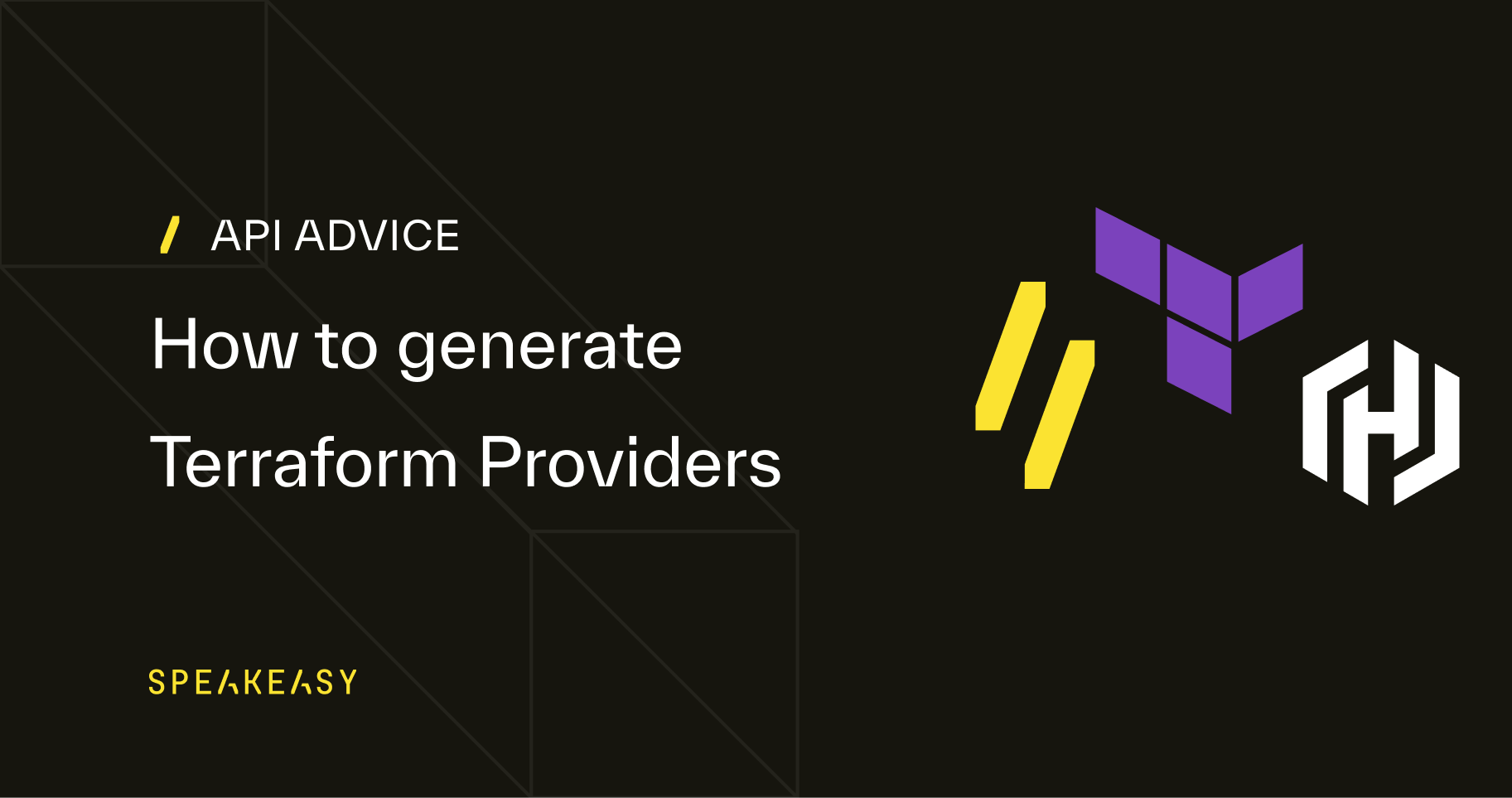
API Advice
How to Generate Terraform Providers
Thomas Rooney
February 21, 2024

HashiCorp (creators of Terraform) recently released a tool for automatically creating Terraform provider data types from your OpenAPI documents. In this post we'll do a full walkthrough of how to use both of these tools, but before getting into the details, here's a high level summary of the differences between the two:
- Speakeasy generates the complete Go project for you from your annotated schema, ready for release. HashiCorp generates only data types for your resource and data schemas, and you need to write and maintain a lot of additional Go code.
- The HashiCorp Terraform provider generator is currently "in tech preview". As the tool is finalized and reaches production status, it may be able to generate more aspects of the provider (we'll update this post as things change).
- Because the Speakeasy workflow is end to end, it is easy to fully automate the generation. Speakeasy has a Github Action that can easily be added to your CI/CD. Hashicorp would require a custom script to pull together a couple of tools in order to fully automate the generation.
- The HashiCorp generator uses a separate mapping file to track, while the Speakeasy generator uses extension attributes in the schema. Which approach is better is a matter of preference. Keeping mapping details in a separate file means less additions to your canonical API definition, but it also means keeping two separate files in sync.
- In contrast to Speakeasy's "OpenAPI-first" philosophy, HashiCorp uses an intermediate format between the OpenAPI schema and the provider. This format is theoretically useful if you want to create a provider with something other than OpenAPI, such as directly from your API codebase. But in that case, you probably would need to write a custom script, as there is no tool for this yet.
For those who need it, let's start with a brief overview of Terraform providers and how they work. Otherwise, you can skip ahead to Generating a Terraform Provider
What Is a Terraform Provider?
Terraform is a free tool to manage infrastructure with configuration files. For instance, you can call Terraform to create identical AWS servers ready to run an application in development, test, and production environments by giving it the same configuration file for each environment. A Terraform provider is a plugin to the Terraform core software that allows Terraform to access resources that live in a 3rd party system (for example, the AWS provider allows access to AWS, the system that manages cloud infrastructure resources).
Why Build a Terraform Provider for an API?
If your API calls a stateless service (to get a share price, for instance, or charge a credit card), there is nothing for configuration files to manage. However, if your API manages any resource that persists (like user permissions or an accounting system), you could offer your users a custom Terraform provider as an interface to your API, allowing them to call your service through a standard set of configuration files.
For a more thorough conversation of Terraform providers and examples, see our article on the benefits of Terraform providers (opens in a new tab).
About Terraform Providers
Terraform providers are modules written in Go as plugins for Terraform.
When you install a Terraform provider with go install, it is saved to the go path, for example, root/go/bin.
The Terraform provider filename will match the first line in the module's go.mod file. For example, the following:
module github.com/speakeasy/terraform-provider-terraform
Will match the file root/go/bin/terraform-provider-terraform.
However, the name you use for the provider in the source field of the Terraform resource configuration file comes from your module's main.go file. In this excerpt:
terraform { required_providers { terraform = { source = "speakeasy/terraform" version = "0.0.3" } }}
The name used in the source field comes from the module's main.go file:
opts := providerserver.ServeOpts{ Address: "registry.terraform.io/speakeasy/terraform",
When building and testing Speakeasy and HashiCorp providers locally, you need to match your Terraform repository overrides to the main.go field in .terraformrc:
provider_installation { dev_overrides { "speakeasy/terraform" = "/root/go/bin" "terraform-provider-petstore" = "/root/go/bin" } direct {}}
Generating a Terraform Provider
Prerequisites
If you would like to create a Terraform provider by following this tutorial, you'll need Docker (opens in a new tab) installed. Alternatively, you can install Go, Node.js, Speakeasy, Terraform, and the Terraform provider creation modules on your local machine.
Below is a Dockerfile that creates an image prepared with Go, Terraform, Speakeasy, and the new HashiCorp codegen framework that you can use to run all the code in this article. Replace the Speakeasy key with your own on line nine and save the file as Dockerfile.
FROM --platform=linux/amd64 alpine:3.19WORKDIR /workspaceRUN apk add go curl unzip bash sudo nodejs npm vimENV GOPATH=/root/goENV PATH=$PATH:$GOPATH/binENV SPEAKEASY_API_KEY=SET_YOUR_API_KEY_HERE# install terraform:RUN curl -O https://releases.hashicorp.com/terraform/1.7.0/terraform_1.7.0_linux_amd64.zip && \ unzip terraform_1.7.0_linux_amd64.zip && \ mv terraform /usr/local/bin/ && \ rm terraform_1.7.0_linux_amd64.zip# install openapi terraform provider framework:RUN go install github.com/hashicorp/terraform-plugin-codegen-framework/cmd/tfplugingen-framework@latestRUN go install github.com/hashicorp/terraform-plugin-codegen-openapi/cmd/tfplugingen-openapi@latest# install speakeasyRUN curl -fsSL https://raw.githubusercontent.com/speakeasy-api/speakeasy/main/install.sh | sh
Run the following commands in a terminal to start using the Dockerfile:
mkdir codedocker build -t seimage . # build the imagedocker run -it --volume ./code:/workspace --name sebox seimage # run the container using the code folder to work in# Run this command if you need to start the container again later:# docker start -ai sebox
In another terminal on your host machine (not inside Docker), run the code below to create folders to work in for the Speakeasy and HashiCorp examples:
cd codemkdir hashi # hashicorpmkdir se # speakeasycd setouch openapi.yaml
You need to give your host user write permissions to files created in the container to edit them. On Unix-like systems, use the following command on your host machine, replacing myusername with your user name:
sudo chown -R myusername:myusername code
Now insert the Swagger Petstore example schema (available here (opens in a new tab)) into the openapi.yaml file. The Swagger Petstore example schema is the API description of a service that manages pets and orders for pets at a store.
Create a Terraform Provider With the HashiCorp Provider Spec Generator
The HashiCorp automated Terraform provider creator (opens in a new tab) works differently from Speakeasy. HashiCorp provides an API SDK to convert your OpenAPI schema into an intermediate format, called the provider code specification (JSON). This document is then transformed into a provider by Terraform SDK. These transforming SDKs are both CLI tools.
An OpenAPI schema does not describe which Terraform resource each operation maps to. So, like Speakeasy extension attributes, you need to include mapping information in a generator configuration file along with your schema.
You can create a provider by starting at any one of the three steps:
- Start with an OpenAPI schema (opens in a new tab), as with Speakeasy.
- Write a provider code specification manually (opens in a new tab), or with some tool the Terraform community may develop in the future, without using OpenAPI at all. Writing a provider code specification is closely coupled to the Terraform system and allows you to precisely create a compatible provider. You can even include custom Go functions to map objects between your API and Terraform. The full list of features with examples is here (opens in a new tab).
- Create a provider manually by coding it in Go (the traditional way).
As noted in the HashiCorp code generation design principles (opens in a new tab), there is a mismatch between an OpenAPI schema and a Terraform provider. Providers expect resources, transfers, and errors to relate in a way that an API doesn't. For this reason, it's unlikely that there will ever be a general solution to creating a provider from a schema that does not require annotations like Speakeasy extension attributes or a HashiCorp generator configuration.
The HashiCorp Workflow Example
HashiCorp provides a full walkthrough for creating a Terraform provider from a schema (opens in a new tab). The Docker container you have been working in has everything you need to follow the Hashicorp walkthrough if you'd like to. Change to the hashi folder and continue working.
We don't repeat HashiCorp's tutorial here, but let's take a look at the steps and how the process differs from Speakeasy.
- HashiCorp doesn't create a full Go project for you. You need to create one with
go mod init terraform-provider-petstore. - You need to use the framework code generator
scaffoldcommand to create a template for the Go provider code, and write your ownmain.gofile. - Instead of adding attributes to your schema, you create a
generator_config.ymlfile to hold the mapping between the schema and the provider. It looks like this:provider:name: petstoreresources:pet:create:path: /petmethod: POSTread:path: /pet/{petId}method: GETschema:attributes:aliases:petId: id - The
tfplugingen-openapi generatecommand creates a provider code specification in JSON from your schema, and thentfplugingen-framework generatecreates the provider from the provider code specification, like so:tfplugingen-openapi generate \--config ./generator_config.yaml \--output ./specification.json \./openapi.yaml &&tfplugingen-framework generate all \--input specification.json \--output internal/provider - This creates the Go files
internal/provider/provider_petstore/petstore_provider_gen.goandinternal/provider/resource_pet/pet_resource_gen.go. The_genin the filename is a hint that a tool created the file, and it should not be edited manually. - The HashiCorp Terraform provider generator does not create all the code you need. It creates only the Go data types for the pet resource, not the code that manages the data. In the middle of the HashiCorp Terraform provider generation walkthrough, you can see that a long page of code needs to be copied and pasted into
/internal/provider/pet_resource.go.
Create a Terraform Provider With Speakeasy
In the Docker container terminal, navigate to the se directory using the command cd /workspace/se and run the following command to check that your OpenAPI schema is acceptable to Speakeasy:
speakeasy validate openapi -s openapi.yaml;
The Petstore schema has three object types: pet, order, and user. To test Terraform providers, we'll implement the addPet and getPetById operations. Terraform will use these two operations to create a single pet, and then check if the pet exists when verifying the Terraform state against the API. These operations correspond to Create and Read in CRUD.
Add Speakeasy Terraform Annotations
We use Speakeasy extension attributes in a schema to have Speakeasy create a Terraform provider. The Speakeasy extensions tell Terraform which OpenAPI schema operations map to which CRUD operations for each resource, and which field is the ID.
Read our overview of how the Terraform provider creation process works (opens in a new tab) or view the full list of Speakeasy Terraform extensions (opens in a new tab) for more information about creating Terraform providers with Speakeasy.
Insert the following commented lines into openapi.yaml:
... post: tags: - pet summary: Add a new pet to the store description: Add a new pet to the store x-speakeasy-entity-operation: Pet#create # <----- operationId: addPet... /pet/{petId}: get: tags: - pet summary: Find pet by ID description: Returns a single pet operationId: getPetById x-speakeasy-entity-operation: Pet#read # <----- parameters: - name: petId x-speakeasy-match: id # <-----...components: schemas: ... Pet: x-speakeasy-entity: Pet # <----- required: - name - photoUrls type: object...
Validate the schema and create the provider in the Docker container:
speakeasy validate openapi -s openapi.yaml &&speakeasy generate sdk --schema openapi.yaml --out sdk --lang terraform
Speakeasy creates a Terraform provider (Go module) in the sdk folder.
Speakeasy Security Support
In most cases, Speakeasy should support security in providers (opens in a new tab):
Every authentication mechanism that relies on static authorization is supported with its values automatically available to be configured in the provider configuration.
But you may encounter instances where this will not be true in practice. If you create a provider for the Petstore schema without removing the security elements, when you run go run main.go --debug, you'll get the error:
internal/provider/pet_data_source.go:135:43: not enough arguments in call to r.client.Pet.GetPetByID have (context.Context, operations.GetPetByIDRequest) want (context.Context, operations.GetPetByIDRequest, operations.GetPetByIDSecurity)
In this instance, Speakeasy will not create a provider, as the API method is defined to have differing resource security configuration to the global provider security configuration in the OpenAPI specification.
Similarly, for oAuth2 authenticated APIs, the authentication mechanism between a Client and a Token endpoint is ambiguous, even in the (latest) OpenAPI 3.1 Specification. Speakeasy currently natively supports the client_secret_post oAuth2 authentication schema as described in Section 9 of OpenID Connect Core 1.0 (opens in a new tab), under the client credentials flow, but does require that some code is written to help authenticate your provider with your service for your flavour of authentication.
Install the Terraform Provider
Run the commands below in the Docker terminal to install the Terraform provider as root/go/bin/terraform-provider-terraform:
cd sdkgo install
You need to edit the Terraform settings file to redirect provider requests from the online Terraform repository to the custom local provider we created, or Terraform will try to find a provider online for your service and fail. The file is not in the shared code folder, so you need to edit it in the Docker terminal. Below we use Vim.
vim /root/.terraformrc# inside vim:# i to enter into edit mode# ctrl-shift-v to paste the text below:provider_installation { dev_overrides { "speakeasy/terraform" = "/root/go/bin", "terraform-provider-petstore" = "/root/go/bin" } direct {}}# escape to exit edit mode# :wq to write and quit vim
Here we add terraform-provider-petstore in addition to the Speakeasy line so that your container is ready to run the HashiCorp tutorial later.
Call the Provider From Terraform
Now that the provider is installed and ready, we need a Terraform resource configuration file as input.
Insert the code from sdk/examples/provider/provider.tf (which defines the provider to use) into sdk/examples/resources/terraform_pet/resource.tf (which defines the resource to change). The final sdk/examples/resources/terraform_pet/resource.tf file should look like this:
terraform { required_providers { terraform = { source = "speakeasy/terraform" version = "0.0.1" } }}provider "terraform" { # Configuration options}resource "terraform_pet" "my_pet" { id = 10 name = "doggie" photo_urls = [ "...", ] status = "available"}
Now we can call the Petstore service through the API using Terraform and the resource configuration file. In Docker:
cd /workspace/se/sdk/examples/resources/terraform_petterraform planterraform apply
The result is an expected Terraform execution:
/workspace/se/sdk/examples/resources/terraform_pet # terraform apply╷│ Warning: Provider development overrides are in effect││ The following provider development overrides are set in the CLI configuration:│ - speakeasy/terraform in /root/go/bin│ - speakeasy/hashicups in /root/go/bin││ The behavior may therefore not match any released version of the provider and applying changes may cause the state to become incompatible with published releases.╵Terraform used the selected providers to generate the following execution plan. Resource actions are indicated with the following symbols: + createTerraform will perform the following actions: # terraform_pet.my_pet will be created + resource "terraform_pet" "my_pet" { + category = (known after apply) + id = 10 + name = "doggie" + photo_urls = [ + "...", ] + status = "available" + tags = (known after apply) }Plan: 1 to add, 0 to change, 0 to destroy.Do you want to perform these actions? Terraform will perform the actions described above. Only 'yes' will be accepted to approve. Enter a value: yesterraform_pet.my_pet: Creating...terraform_pet.my_pet: Creation complete after 2s [name=doggie]Apply complete! Resources: 1 added, 0 changed, 0 destroyed.
You'll notice we do not have a local implementation of the API service running somewhere for the provider to call. The Petstore example is a real service provided online by Swagger. You can see the URL in the server field of the schema. For example, you can browse to an operation at https://petstore3.swagger.io/ (opens in a new tab).
If you are building your own API, you'll need to make a service the provider can call.
Summary of the Speakeasy Terraform Provider Creation Process
Let's review what we did:
- Annotate an OpenAPI schema file with Speakeasy extension attributes to indicate which operations are for which Terraform CRUD functions.
- Remove security elements and non-JSON request and response elements.
- Create the Terraform provider Go code with Speakeasy.
- Compile and install the provider.
- Redirect Terraform settings to use the local provider.
- Make a Terraform resource configuration file.
- Run Terraform against the file.
As your API changes over time and you release new Terraform provider versions to clients, you will need to add extension attributes. Apart from that, the Terraform provider creation process should be an automated set of terminal commands.
Comparison and Conclusion
In conclusion, Speakeasy provides a complete solution for creating a Terraform provider from a schema with only one manual step. The HashiCorp automated Terraform provider generator is not ready for production use yet, but is something to keep an eye on during 2024 to see how it catches up. The HashiCorp provider code specification intermediate language will also benefit from the massive Terraform community building plugins.
Read our case study on how leading data integration platform Airbyte uses Speakeasy (opens in a new tab) to create and maintain Terraform providers alongside SDKs and minimize engineer burden.
Further Reading
- Benefits of providers for an API (opens in a new tab)
- Original Petstore example (opens in a new tab)
- Annotated Petstore example (opens in a new tab)
- HashiCorp provider example (opens in a new tab)
- Speakeasy provider example (opens in a new tab)
- OpenTofu — the open-source Terraform substitute (opens in a new tab)
HashiCorp Automated Terraform Provider Creation
- Documentation overview (opens in a new tab)
- Provider code specification documentation (opens in a new tab)
- OpenAPI schema SDK (opens in a new tab)
- Terraform SDK (opens in a new tab)

